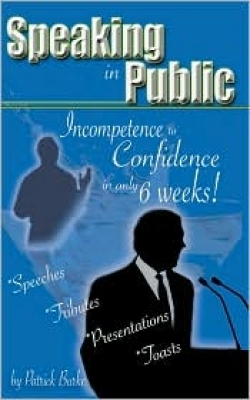Speaking in Public
Incompetence to Confidence in Only 6 Weeks
Death and public speaking: the two most common fears for Americans. Patrick Burke believes that the fear of public speaking can be overcome. He presents his method for gaining confidence in Speaking in Public: Incompetence to Confidence in only 6 Weeks. In this slim volume, Burke draws on his experiences as a presenter and independent consultant as well as his work as a trainer for Speak First, a communication skills training company in the United Kingdom.
Burke begins by identifying three basic points of good speaking: content, body language, and voice. He uses these points to organize the bulk of the book. Following his own advice, he reviews the principles discussed before forecasting the key idea of the next chapter. Periodically, he asks the reader to rate his or her increasing confidence.
In addition to covering the basics, Burke includes chapters on using visual aids, dealing with a question/answer session, impromptu speaking, and special occasions such as a wedding or a funeral. These situations are often overlooked in more traditional texts but are probably among the most commonly faced by the average person. His suggestions for success in these circumstances are among the most useful in the book. In his discussion of wedding toasts, he presents an outline of the topics that may properly be covered by the bride’s father, a relative or friend of the bride, the groom, the best man, and even the bride.
The author’s suggestions for dealing with nervous tension are specific and practical. He identifies examples of effective speakers (Barack Obama and Richard Branson) that readers can observe in the media. He also includes brief and specific examples from his own experience.
The book would work best as a supplement to an instructional presentation, since it lacks elements necessary in a self-help book, such as activities that a student might do independently. For instance, in the section on gathering material Burke suggests four different graphic organizers a speaker might use instead of a list “to create total freedom of thought.” However, the book doesn’t include illustrations and thorough step-by-step instructions on breaking through inhibitions and using any of these.
The most obvious shortcoming in this book is the absence of internal sentence punctuation. Since Burke knows the importance of voice in public speaking, he should realize how commas assist and support the “voice” of the author.
Individuals most in need of help with public speaking will not gain the fullest benefit of Burke’s knowledge and experience by reading this list of suggestions. Without additions, only highly motivated individuals will succeed at reducing their fear of public speaking.
Reviewed by
Geraldine Richards
Disclosure: This article is not an endorsement, but a review. The publisher of this book provided free copies of the book and paid a small fee to have their book reviewed by a professional reviewer. Foreword Reviews and Clarion Reviews make no guarantee that the publisher will receive a positive review. Foreword Magazine, Inc. is disclosing this in accordance with the Federal Trade Commission’s 16 CFR, Part 255.

